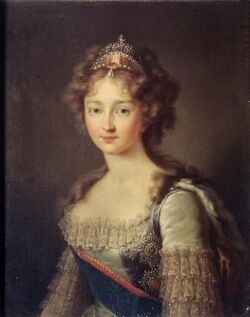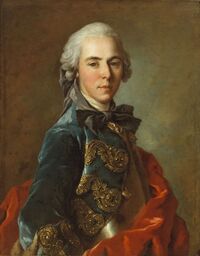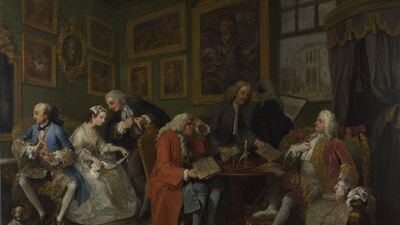Difference between revisions of "Amadea of Pompourelia"
| Line 33: | Line 33: | ||
'''Amadea Ulyssa de Sarkozy''' was born upon the 13th of Owyn's Flame, 1789 in [[Helena]], to [[George Ulysses, 2nd Count of Pompourelia]] and his wife, Princess Amalie of Muldav. She was named after her late paternal uncle, Peter Amadeus, as well as taking the female equivalent of her Father's own middle name. Her complex and varied royal lineage traces to [[Joseph II, Holy Orenian Emperor|Emperor Joseph II]] (as his grand-niece via her Father's line), [[Adrian I of Kaedrin]] (as his great-granddaughter via her maternal grandmother), and a further descendant from both the Johannian and Aurelian Imperial lines via her paternal grandmother, [[Henrietta, Princess of Alstion]]. | '''Amadea Ulyssa de Sarkozy''' was born upon the 13th of Owyn's Flame, 1789 in [[Helena]], to [[George Ulysses, 2nd Count of Pompourelia]] and his wife, Princess Amalie of Muldav. She was named after her late paternal uncle, Peter Amadeus, as well as taking the female equivalent of her Father's own middle name. Her complex and varied royal lineage traces to [[Joseph II, Holy Orenian Emperor|Emperor Joseph II]] (as his grand-niece via her Father's line), [[Adrian I of Kaedrin]] (as his great-granddaughter via her maternal grandmother), and a further descendant from both the Johannian and Aurelian Imperial lines via her paternal grandmother, [[Henrietta, Princess of Alstion]]. | ||
| − | Amadea was the firstborn and only child to the Count and Countess of Pompourelia, and as such was regarded as the heir to the comital title throughout her youth. At her birth, she was betrothed to [[Prince Philip Aurelian of Crestfall]], who was third in line for the Imperial throne and widely believed to be the successor to the childless Crown Prince | + | Amadea was the firstborn and only child to the Count and Countess of Pompourelia, and as such was regarded as the heir to the comital title throughout her youth. At her birth, she was betrothed to [[Prince Philip Aurelian of Crestfall]], who was third in line for the Imperial throne and widely believed to be the successor to the childless Crown Prince John Charles, as his brother Philip Augustus (Philip Aurelian's father) was only a few years younger than him and would thus be an unlikely ascendant to the throne. The Orenian Crown furthermore saw it fit to reunite the lines of Sarkozy and Novellen through Amadea's marriage, as she was the sole inheritor to the Pompourelian line of de Sarkozy. |
[[File:babyamadea.jpg|thumb|left|200px|''The Pompourelian Heiress" (circa 1794), by Swanhilda de Owynsburg. This portrait was delivered to the residence of the [[Prince Philip, Duke of Crestfall|Duke of Crestfall]] in order to show him what his son's future bride looked like.'']] | [[File:babyamadea.jpg|thumb|left|200px|''The Pompourelian Heiress" (circa 1794), by Swanhilda de Owynsburg. This portrait was delivered to the residence of the [[Prince Philip, Duke of Crestfall|Duke of Crestfall]] in order to show him what his son's future bride looked like.'']] | ||
Revision as of 12:51, 22 May 2021
|
|
Amadea Ulyssa (13th of Owyn’s Flame, 1789 – Present) was the firstborn and only child of George Ulysses, 2nd Count of Pompourelia and his wife, Amalie (neè Alimar). She was betrothed at birth to the firstborn son of Prince Philip, Duke of Crestfall and third in the line of Imperial succession, Prince Philip Aurelian of Crestfall.
Contents
Early Life
Amadea Ulyssa de Sarkozy was born upon the 13th of Owyn's Flame, 1789 in Helena, to George Ulysses, 2nd Count of Pompourelia and his wife, Princess Amalie of Muldav. She was named after her late paternal uncle, Peter Amadeus, as well as taking the female equivalent of her Father's own middle name. Her complex and varied royal lineage traces to Emperor Joseph II (as his grand-niece via her Father's line), Adrian I of Kaedrin (as his great-granddaughter via her maternal grandmother), and a further descendant from both the Johannian and Aurelian Imperial lines via her paternal grandmother, Henrietta, Princess of Alstion.
Amadea was the firstborn and only child to the Count and Countess of Pompourelia, and as such was regarded as the heir to the comital title throughout her youth. At her birth, she was betrothed to Prince Philip Aurelian of Crestfall, who was third in line for the Imperial throne and widely believed to be the successor to the childless Crown Prince John Charles, as his brother Philip Augustus (Philip Aurelian's father) was only a few years younger than him and would thus be an unlikely ascendant to the throne. The Orenian Crown furthermore saw it fit to reunite the lines of Sarkozy and Novellen through Amadea's marriage, as she was the sole inheritor to the Pompourelian line of de Sarkozy.
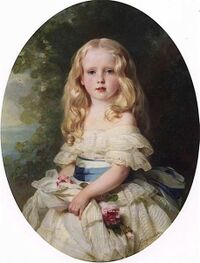
An Imperial Ambassador described a young Amadea as looking very similar to her Mother, with pale blonde hair and fair skin - bearing large blue eyes similarly coloured to her uncle, Joseph II. She was rather short for her age, reaching only the height of 5'3 within her life. The Ambassador remarked that she was "nothing extraordinary, as Lady Wilhelmina was", but that the heiress would "do finely with a crown atop her head".
Her early childhood was spent within the Orenian countryside of Arcas, until the Inferi Invasion in 1796 led the Empire to re-establish itself within the city of Providence upon the continent of Almaris. From thereon, she lived in the Augustine Palace under the rule of Empress Anne I and Emperor Joseph II. After a familial dispute her Mother had departed the Empire, and her Father left the entirety of Amadea's education and upbringing within the hands of a number of court tutors. However, these tutors for the most part were irresponsibly neglectful, leaving her with only the company of gossip-prone servants and her loyal dalmatian Augustus. Archchancellor Franz Nikolai, Amadea's distant cousin, described the poor education of the Future Empress as an "Insult to the Imperial Line", and upon meeting her in 1803, arranged to oversee the remainder of her upbringing alongside his wife Irene.
From thereon, Amadea became more aware of the affairs of state, and took a keen interest in music - particularly through learning the Pianoforte. She developed a close relationship with her cousin the Baroness of Carrington and standing Governess of the Augustine Palace, slowly beginning to assume her place within the court. She worked together with the Governess to solidify her position as the successor to the Imperial Court, marking the beginning of what would become Amadea's lifetime focus.
Marriage
Amadea's betrothal to Prince Philip Aurelian of Crestfall, five years her senior, was solidified within days of her birth. The messy affair of Crown-Prince John Charles' marriage led the Imperial Crown to desire a strong imperial union, and thus when the Count of Pompourelia announced the birth of his daughter, she was selected as the most viable candidate. John Charles' further lack of children led the Imperial line of succession to fall to his younger brother, Philip Augustus. Due to the close ages of the two sons of Anne I and Joseph II, it was widely regarded that the next inheritant following John would be his nephew, Philip Aurelian. As such Amadea's betrothal positioned her to be the future Empress-Consort of the Holy Orenian Empire.
The pair first met within a Royal ball at the Augustine Palace in the summer of 1800 when Amadea was eleven years old. The heiress described her betrothed to her confidante Anna Pruvia as a "tender-hearted young fellow", and the two continued to exchange cordial letters following their first meeting and throughout their later adolescence.
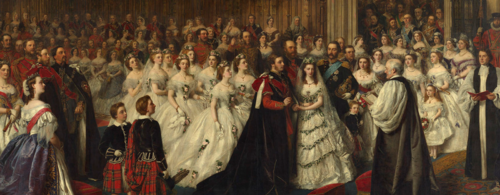
The pair were later wed upon the 14th of Tobias' Bounty, 1809 - two month's after Amadea's twentieth birthday. They married in the Cathedral of Providence, and their wedding was overseen by the High Pontiff Jude II. Amassing over 100,000 attendees, the period of festivities surrounding the union continued for a number of months following. Amadea wore an extravagant gown tailored by Joanne Selm, niece to the famed Orenian tailor Mary of Sunholdt. It included the 'New Orenian' style of a wider bust and more shapely corset, with intricate gold trimmings lining the edges of her skirt and sleeves. Upon her head she donned the diadem of her grandmother, Princess Henrietta of Alstion.
Immediately following the wedding Philip was granted the County of Renzfeld, and as such Amadea became the Countess.
As Countess of Renzfeld
Following her wedding (and as such ascension to an Imperial Princess), Amadea immediately set about further establishing her role within the courts and within the empire as a whole. She began to surround herself with an array of similarly-minded ladies, beginning to form the core of her own future court. These included figures such as Anna Pruvia, Mary d'Arkent, Helena Basrid, and her cousin-in-law, Princess Charlotte Augusta. Together, they drafted the initial plans for a new court restructure. The absence of an incumbent Empress (or crown-princess, given Wilhelmina's seclusion) allowed the Countess to expand her influence, quickly assuming her place as one of the leading women of the Imperial household - perhaps only secondary to the Princess Imperial.
Across this period, Amadea's social authority only continued to grow, with her character and afamed beauty earning her the veneration of a significant portion of the courts. Little Imperial girls spoke of their admiration for the Countess, and their elder counterparts fought for her recognition. Though not a woman with the sharpest of intellect, partly due to her poor education as a child, Amadea was certainly well-versed in one thing - how to command the attention of Imperial Society. Her audacious and wildly expensive taste in fashion and jewellery, as well as her distinct emphasis upon physical appearance and social order earned her the disfavour of some progressive Orenians, however the majority regarded the Countess as the exact picture of the Empire's long-awaited Empress-Consort, a role in which had been vacant since Peter III's wife had died in 1767.
However, her largest shortcoming came within the substantial time in which she seemed unable to produce an heir. Prince Philip and Amadea had wed in 1809, and and the Countess herself was known to have boasted abundantly of her plans to secure the Imperial line of succession - in short, to succeed where Crown-Princess Wilhelmina had not. Despite her assurances, the initial years of the pair's marriage suggested the opposite. The Countess' first pregnancy came in 1809, a few months following the wedding, however resulted in an early miscarriage. This was followed by several more, in 1810, 1812 and 1813, each of which produced the same result - the loss of the child. Believing herself a poor example of an Imperial Princess and fearing for her reputation, she chose to keep the news of her miscarriages and any further pregnancies largely private. It was only Philip himself, alongside a few select advisors, who knew of the Countess' struggle. She retreated from such a pronounced place in the public eye, desperate to provide the Empire with a future Emperor.
Her prayers were however finally answered in 1815 with the birth of a healthy baby boy, christened as Prince Philip Amadeus of Renzfeld. Due to her fears and subsequent secrecy of her pregnancy, it came as a surprise to the court when the Countess stood before the Noble Summons and announced the birth of the Empire's future heir. Amadea was overjoyed, and spokeWith newfound vigour, Amadea returned to her previous place in the court, being notable involved within the Social Season of 1816, where she took upon a significant role in the organisation and participation of various events across the year. This allowed her to expand her influence across the slightly younger generation of Imperials, and as her own future subjects, she placed a great deal of importance in building her relationship with the Debutantes and Bachelors of the Season. This was an incredibly prosperous period for the Countess, and the Season ended on an even further high note with the birth of her second son, John Casimir. Amadea and Philip's third and final son, George Maximilian, was born two years later.
Three consecutively born sons only further solidified Amadea's influence, securing the Imperial line of succession after the childless Emperor John VIII.
Titles and Styles
- 1789 - 1809 The Right Honourable, Lady Amadea Ulyssa of Pompourelia
- 1809 - present Her Imperial Highness, The Countess of Renzfeld
Issue
| Name | Birth | Death | Marriage | |
|---|---|---|---|---|
| Prince Philip Amadeus of Renzfeld | 1815 | Alive | Unwed | Firstborn child to Amadea and Prince Philip of Crestfall. Fourth in line to the Imperial Throne at the time of his birth. Named after both Amadea and Philip. |
| Prince John Casimir of Renzfeld | 1817 | Alive | Unwed | Secondborn child to Amadea and Prince Philip of Crestfall. Fifth in line to the Imperial Throne at the time of his birth. Named in honour of the Emperor at the time, John VIII |
| Prince George Maximilian of Renzfeld | 1819 | Alive | Unwed | Thirdborn child to Amadea and Prince Philip of Crestfall. Sixth in line to the Imperial Throne at the time of his birth. Named in honour of Amadea's Father, George |
Ancestors
| Ancestors of Amadea of Pompourelia | ||||||||||||||||||||||||||||||||||||||||||||||||||||||||||||||||||||||||||||||||||||||||||||||||||||||||||||||||||||||||||||||||||||||||||||||||||||||||||||||||||||||||||||||||||||||||||||||||||||||||||||||||||||||||||||||||||||||||||||||||||||||||||||||||||||||||||||||||||||||||||||||||||||||||||||||||||||||||||||||||||||||||||||||||||||||||||||||||||||||||||||||||||||||||||||||||||||||||||||||||||||||||||||||||||||||||||||||||||||||||||||||||||||||||||||||||||||||||||||||||||||||||||||||||||||||||||||||||||
|---|---|---|---|---|---|---|---|---|---|---|---|---|---|---|---|---|---|---|---|---|---|---|---|---|---|---|---|---|---|---|---|---|---|---|---|---|---|---|---|---|---|---|---|---|---|---|---|---|---|---|---|---|---|---|---|---|---|---|---|---|---|---|---|---|---|---|---|---|---|---|---|---|---|---|---|---|---|---|---|---|---|---|---|---|---|---|---|---|---|---|---|---|---|---|---|---|---|---|---|---|---|---|---|---|---|---|---|---|---|---|---|---|---|---|---|---|---|---|---|---|---|---|---|---|---|---|---|---|---|---|---|---|---|---|---|---|---|---|---|---|---|---|---|---|---|---|---|---|---|---|---|---|---|---|---|---|---|---|---|---|---|---|---|---|---|---|---|---|---|---|---|---|---|---|---|---|---|---|---|---|---|---|---|---|---|---|---|---|---|---|---|---|---|---|---|---|---|---|---|---|---|---|---|---|---|---|---|---|---|---|---|---|---|---|---|---|---|---|---|---|---|---|---|---|---|---|---|---|---|---|---|---|---|---|---|---|---|---|---|---|---|---|---|---|---|---|---|---|---|---|---|---|---|---|---|---|---|---|---|---|---|---|---|---|---|---|---|---|---|---|---|---|---|---|---|---|---|---|---|---|---|---|---|---|---|---|---|---|---|---|---|---|---|---|---|---|---|---|---|---|---|---|---|---|---|---|---|---|---|---|---|---|---|---|---|---|---|---|---|---|---|---|---|---|---|---|---|---|---|---|---|---|---|---|---|---|---|---|---|---|---|---|---|---|---|---|---|---|---|---|---|---|---|---|---|---|---|---|---|---|---|---|---|---|---|---|---|---|---|---|---|---|---|---|---|---|---|---|---|---|---|---|---|---|---|---|---|---|---|---|---|---|---|---|---|---|---|---|---|---|---|---|---|---|---|---|---|---|---|---|---|---|---|---|---|---|---|---|---|---|---|---|---|---|---|---|---|---|---|---|---|---|---|---|---|---|---|---|---|---|---|---|---|---|---|---|---|---|---|---|---|---|---|---|---|---|---|---|---|---|---|---|---|---|---|---|---|---|---|---|---|---|---|---|---|---|---|---|---|---|---|---|---|---|---|---|---|---|---|---|---|---|---|---|---|---|---|---|---|---|---|---|---|---|---|---|---|---|---|---|---|---|---|---|
|
|
||||||||||||||||||||||||||||||||||||||||||||||||||||||||||||||||||||||||||||||||||||||||||||||||||||||||||||||||||||||||||||||||||||||||||||||||||||||||||||||||||||||||||||||||||||||||||||||||||||||||||||||||||||||||||||||||||||||||||||||||||||||||||||||||||||||||||||||||||||||||||||||||||||||||||||||||||||||||||||||||||||||||||||||||||||||||||||||||||||||||||||||||||||||||||||||||||||||||||||||||||||||||||||||||||||||||||||||||||||||||||||||||||||||||||||||||||||||||||||||||||||||||||||||||||||||||||||||||||

